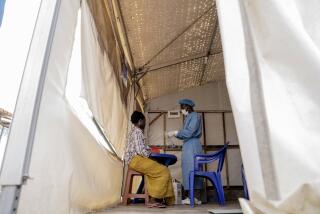Bigger Risk Seen of U.S. Foot-Mouth Outbreak
NEW YORK — The director of the federal laboratory that tests for foot-and-mouth disease said Tuesday that travel patterns have increased the possibility of the disease moving from England to the United States.
“The chances are greater today than they were three months ago,” said David Huxsoll, director of the Department of Agriculture’s Plum Island Laboratory here. “There are a lot of people who go to Europe. They go through Britain.”
He added that a yeoman’s effort by the USDA has kept the disease out of the United States for more than 70 years.
Foot-and-mouth disease, while not a health risk to humans, is highly contagious to livestock. Only North America, Antarctica and Australia are free of the disease.
A widespread outbreak in the United States could cost the agriculture industry here billions of dollars. So the occurrence in England--followed by cases in France, the Netherlands and Ireland--has caused U.S. authorities to take diverse measures to prevent the disease’s spread.
“We are doing everything we can to make sure it doesn’t come into this country,” Agriculture Secretary Ann M. Veneman said Tuesday.
“When you see . . . foot-and-mouth reach places like Europe and expand in Europe,” said USDA spokesman Kevin Herglotz, “the risk [of it reaching the U.S.] is greater, which is why we increase what we are doing.”
As part of its prevention and potential containment strategy, the USDA sent a team of 40 veterinarians to England to help with surveillance and eradication.
The agency has banned the import of livestock, raw meat and other products that could carry the disease. The USDA also has prohibited bringing used farm equipment into the United States from areas where outbreaks have occurred.
Extra personnel have been stationed at border checkpoints, airports and ports to question people entering the country and, when appropriate, to inspect luggage. The number of dog teams at airports has been doubled to sniff out passengers carrying meat.
The USDA advises travelers coming from infected countries to avoid any livestock facilities and to launder or dry clean all clothing. Dirt and soil should be removed from shoes by wiping them with a cloth dampened in bleach.
Meetings have been held with veterinary officials, state and local agricultural leaders and trade groups nationwide in an attempt to prevent the disease from spreading--and to plan coordination in case it appears.
Foot-and-mouth is a disease that affects sheep, cattle, goats, deer, pigs and other cloven-footed animals. The virus can live up to three weeks. Symptoms include blisters on hoofs and mouths.
Because other ailments can mimic the malady, the role of the government’s laboratory on Plum Island--a small spit of land reachable by ferry off Long Island--is vital.
In March, scientists at Plum Island delivered reassuring news while farmers and government officials waited anxiously.
Tests on tissue samples from swine from Robersonville, N.C., that were suspected of having foot-and-mouth disease proved to be negative.
Huxsoll said laboratory procedures can bring results within hours when the disease is suspected.
The USDA has prepared extensive emergency plans in case of an outbreak. Those plans include the quarantine of infected areas and the destruction of animals.
Last week during a meeting, representatives of government agencies rehearsed a worst-case scenario: an uncontrolled outbreak lasting more than 60 days.
“It is important we plan for the worst,” Herglotz said. “This is nothing new. Federal agencies do this kind of stuff all the time.”
More to Read
Sign up for Essential California
The most important California stories and recommendations in your inbox every morning.
You may occasionally receive promotional content from the Los Angeles Times.










